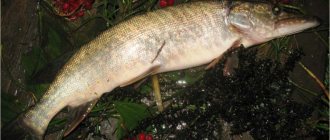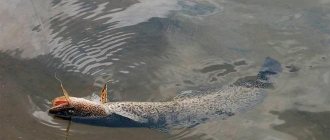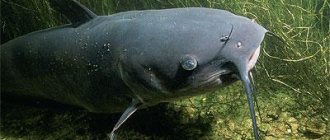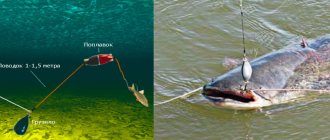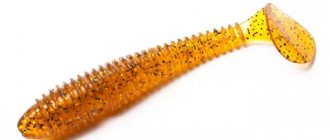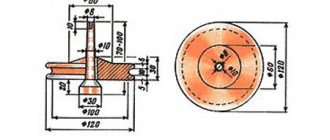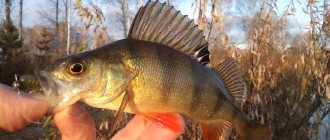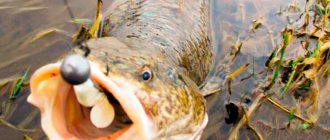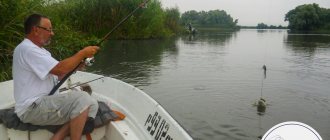Autumn behavior of catfish
Catfish tend to be sedentary in the fall, although they hide throughout the year; at this time they are especially secretive. If other predatory fish are prone to high activity after the end of the spawning period and a week-long “illness,” then the catfish does not behave calmly even during the feeding period.
In autumn, catfish leave their habitats solely to search for food; hunting hours are short. Most often, to catch prey you have to go night fishing. Peculiarities of behavior during the daytime do not allow achieving a good catch, and with the onset of darkness the predator goes hunting.
Catching an underwater hunter can be almost impossible. Catfish are not fast fish, which makes the hunting process difficult. Some individuals hunt from their hiding place; the only way to catch them is to deliver the bait exactly next to the hole. Catfish fishing in the fall can be effective if you cast close to potential predator shelters, since most fish still go out hunting, but wait for prey not far from the shelter.
Catfish, by its nature, is a heat-loving fish
You can hunt catfish until frost, but after a strong drop in water temperature, it loses interest in bait and bait. On rivers in cold regions, fish enter “anabiosis” already in the first ten days of October.
September is the best month for fishing, but you need to know what kind of weather the predator prefers, otherwise you shouldn’t count on catching fish even in September. To understand what weather is best for catching catfish, you should know that during windy and rainy seasons the predator does not leave its hole. Fishing can only be done in good weather. It is best to catch catfish in September due to a slight drop in temperature and the onset of a short feeding period.
There are many ways to catch catfish in the autumn, including coastal gear, since at night the predator approaches the shore to hunt. Mostly when fishing, bottom fishing is used.
Tactics for catching catfish
The first place in a kind of ranking for catfishing rightfully goes to somyatniks who have mastered fishing with kwok. It is difficult to achieve the correct position of the quok when it hits the water, and not everyone succeeds the first time. But after the angler manages to thoroughly study this unique method of fishing, he is guaranteed decent catches until the very end of autumn.
The second place is occupied by the beakers, who cast their gear throughout the night closer to the catfish habitats. In this case, several gears are often used (within the framework of fishing rules) abandoned at different points.
Third place is occupied by trollers, who are ready to swim over promising holes several times in the hope that the ruler of the underwater world will emerge.
On a spinning rod from the shore, catfish, as a rule, are caught rather by accident in the process of catching other predators.
Source: the-fishing.ru
Catching catfish in autumn
Autumn, including late autumn, is not the worst time for fishing. It is in the fall that trophy catfish are most often caught. Of course, with the arrival of cold weather, the mustachioed predator is not as active as at the height of summer, but fewer small tadpole catfish are caught. If there is a powerful bite, you can be sure that a large specimen is sitting on the hook. It’s unlikely to be possible to pull something like this out “on the fly.”
Table of contents
- 1. Autumn habits of the river giant 1.1 Catching catfish in September
- 1.2 In October
- 1.3 In November
- 3.1 Kwok
Most likely, you will have to run along the shore with a rod bent into an arc and get pretty nervous, or ride a boat behind it for more than one hour. But the effort is worth it, because the reward will be large catch and photographs against the background of a bottomless mustachioed mouth, which you are not ashamed to show to your fishing friends. Such moments make catching catfish in the fall an extremely exciting and exciting activity.
Autumn spinning fishing techniques
The autumn technique for catching catfish is no different from the summer one: you also need to act carefully and slowly.
Spinning is universal for hunting predators, including catfish. For jig fishing with a spinning rod, you need a strong rod with a power reel and braided fishing line with a diameter of 0.30 - 0.35 mm. For bait, small fish, an oscillating spoon, a silicone twister or a foam rubber are suitable.
To determine where to catch a predator using a spinning rod, you need to start by combing the deep holes and edges where the catfish hunts in the morning. The bait is introduced slowly, barely touching the bottom, and the lifts are carried out very smoothly.
Many fishermen find this method very exciting, the main thing is a good command of spinning fishing techniques. With the use of a huge heavy curtain the size of a palm or a red and white wobbler, fishing will be much more successful. After catching several predators, you can experiment: bait a spinning rod, for example, with a silicone frog with rotating legs.
An unpredictable catfish can completely overturn an angler’s expectations, and fall fishing will bring many surprises. For a real fisherman, catching large predatory fish is a great gift of fate.
Good luck catching catfish in the fall!
VN:F [1.9.22_1171]
please wait...
Rating: 9.0/10 (total votes: 1)
Catfishing in November, 9.0 out of 10 based on 1 rating
Autumn habits of the river giant
With the onset of cold weather, catfish begin to adhere to a single strategy - to eat as much as possible. Since this predator is very thermophilic, it needs to accumulate a sufficient supply of fat before winter. If in the summer months he goes hunting only at certain hours, mostly at night, then in the fall he can hunt around the clock. This means that with the right place, fishing will be successful at any time, even lunchtime. Only the weather can affect the result.
Catching catfish in September
September is considered the busiest month for catfish fishing in the fall. In the so-called Indian summer, when cobwebs fly everywhere, this predator is so keen on hunting white fish that it drives it all the way to the surface. And this is not his only food. Those who have ever gutted September catfish will never forget the contents of their stomachs. There is everything there, from miniature leeches to the shells of large shells.
Fishing in October
In October, the mustachioed predator becomes somewhat capricious, especially during the rainy season. He prefers to wait out bad weather in some secluded corner, so experienced fishermen do not rush to the reservoir on such days, but patiently wait for weather conditions to improve. In sunny October weather, fishing with a quok brings good results, despite the fact that this “musical instrument” is considered to be purely a summer one. In mid-autumn, catfish begin to move to their wintering holes, and if you know exactly where they are located, you can have excellent fishing along the migration route.
Catfish fishing gear
, 800px">
You can catch catfish using a variety of gear - from expensive branded fishing rods to cheap homemade gear:
Equipped anglers can try their luck at trolling. To do this, you will need a boat with a motor, a high-quality spinning rod, an echo sounder and deep-sea wobblers or heavy large spoons. It is better to first walk over the edges and holes.
If there is no boat, then ordinary hooks will be used, consisting of a thick fishing line, a sinker and a leash with a tee hook. The tackle can be thrown into a pond either using a spinning rod with a reel or by hand. You need to unwind the fishing line from the reel and, spinning the weight above your head, throw it together with the bait into the water.
Fishing with kwok
64w, https://the-fishing.ru/uploads/2018/09/Metallicheskiy-kvok-608×342.jpg 608w, https://the-fishing.ru/uploads/2018/09/Metallicheskiy-kvok-758 ×426.jpg 758w, https://the-fishing.ru/uploads/2018/09/Metallicheskiy-kvok-1152×648.jpg 1152w, https://the-fishing.ru/uploads/2018/09/Metallicheskiy -kvok-313×176.jpg 313w, https://the-fishing.ru/uploads/2018/09/Metallicheskiy-kvok-85×48.jpg 85w, https://the-fishing.ru/uploads/2018 /09/Metallicheskiy-kvok-171×96.jpg 171w, https://the-fishing.ru/uploads/2018/09/Metallicheskiy-kvok.jpg 1280w" data-sizes="(max-width: 662px) 100vw , 662px">
There are many options, but the best way to fish for catfish is with a kwok. This is a special device that is used to splash on the water while moving over the holes in a flotation device. At the same time, the quok emits a specific squelching sound, forcing the lazy predator to leave its home and rise to the surface of the water, where a pre-prepared bait awaits it.
It is still unknown exactly why the catfish reacts so inadequately to the squelching of a piece of wood in the water, but the fact remains that most often the catfish is caught by quok.
Catching catfish using kwok:
Lures for catching catfish
In the fall, catfish are most often caught using the following artificial and animal baits:
- large wobblers capable of diving to great depths, heavy wide spoons, large vibrating tails;
- a bunch of crawling worms;
- shell meat;
- live bait or pieces of fresh fish;
- crayfish;
- frogs;
- chicken giblets or skin.
In different places and at different times, the most catchy baits for catfish can be completely different baits.
Promising places
It is known that the catfish leads a sedentary lifestyle; it rarely leaves its habitable place. As a rule, it settles in large channel holes, loves deep pools, and likes snags and depths near flooded river structures. If there is a depression at the bottom, protected from light by some kind of barrier, you can be 99% sure that a catfish lives in it, and perhaps more than one. The confluence of tributaries will also be promising. Here the current washes out the holes and brings a lot of different food here. But during the autumn feeding season, the freshwater giant still does not have enough of this, so periodically it goes out to shallow water areas to chase the fry.
Catfish can almost always be found where bream are common. Both of them choose places rich in different foods, so they are direct competitors. In addition, any large representative of the catfish family considers young bream as potential prey. When he manages to grab a large fish, signs of a struggle appear on the surface of the water in the form of local disturbances.
A thorough study of the bottom topography is very helpful in catfish fishing. Today, no one does this using the method of “tapping” the bottom, since echo sounders, which were previously expensive and outlandish devices for many, have now become accessible to everyone. Some advanced models scan not only the bottom surface, but also literally see river inhabitants. By their outlines transmitted to the monitor, the fisherman can determine what kind of fish it is.
Tackle and bait for catching catfish in autumn
Only powerful and durable tackle is suitable for fishing this monster, otherwise it will show all its strength and chalk up another victory. Well, the fisherman will be left with his nose and a broken rod. Catfish is a record holder for destroying fishing gear.
As in the summer, in the fall this fish is caught using all types of donks, including simple hooks, spinning rods and quok rods. Since quoting is effective only at the beginning of the autumn season, while there is still relative warmth, we’ll start with it.
Kwok
This method of catching mustache has been known to fishermen since time immemorial. The main element in such fishing is a special mallet called a kwok. Why a beater? Because in the process of fishing, the sotfish hits one end of it on the water, creating characteristic tempting sounds. No one can really explain why they attract catfish. It is believed that they are similar to the calls of a female. Some say that it is similar to the croaking of a frog, which is part of the diet of this predator, while others claim that it itself produces similar sounds when it swallows living creatures. But it is not important. The main thing is that they lift catfish from the holes and lure them to the bait.
Usually, for casting, a tackle consisting of a short, powerful rod and a reliable reel with good traction is used. The equipment is a two-meter leash installed above a sliding sinker weighing 70-100 g. Single or double hooks are used. The thickness of the fishing line and the hook number are selected taking into account the size of the intended prey. The bait is most often a live frog.
The technique of quok fishing is quite simple. The boat drifts with the current over the catfish pits, and behind it at a certain depth a frog drags. In one hand the angler holds the tackle, and with the other he works with a kwok - he hits it on the surface of the water. It’s even better to fish this way with a partner, then everyone will perform their own process: either hold the spinning rod or spank it with a mallet. Hearing an attractive squelching sound, the catfish heads to its source and finds the bait. Then everything is as usual: bite, timely hooking, fishing.
Donka
Catching catfish in the fall with bottom tackle involves using a strong, reliable fishing rod (preferably a feeder), a multiplier reel and a strong fishing line or cord with a cross-section of up to 0.6 mm. The thickness of the leash may be less, but not by much. Any hooks can be used: single, double or tee. The main thing is that they are proportional to the nozzle. Instead of a load, you can use a mesh feeder, filling it with pearl barley meat or crawlies. They are also often put on a hook. In addition to worms, frogs, small crayfish and live bait have also proven themselves well in catching catfish on the bottom.
There is no need to buy expensive equipment for this type of fishing. The fishing line with the equipment can be wound on a reel, as was done before, when fishing stores had nothing but rough bamboo sticks. Donors rely not on the appearance of the gear, but on their quantity. Some place up to fifty snookers, occupying a decent section of the coast, and fish for several days. For others, just one night is enough to bring home a solid catch.
Spinning
In the fall, you can catch catfish using a spinning rod both from the shore and from a boat. In both cases, the tackle must be strong and reliable. The recommended rod test is 40-80 g. The length depends on the fishing method: from the shore - 2.7-3.6 meters, from a boat - 1.7-2.4 meters. The reels used are multiplier ones, although a powerful spinning reel with a spool starting from 3500 is also suitable. It is important to adjust the drag before the first cast, since after a bite and a quick line run out, this will be quite problematic. Instead of monofilament fishing line, it is better to use braided fishing line with a diameter of 0.3 mm.
Places for catching catfish in autumn
The predator bites well all season near deep holes, snags and pools - these are the fish’s favorite hunting places.
Read more
What kind of fish is Chebak?
Additionally, fish prefers:
- confluence areas of small rivers or streams, in which there are washed out holes;
- fallen trees near the shore;
- shady places, as fish do not like light. Protective devices include fallen branches, snags, leaf cover, floating algae, shrubs, etc.;
- washed holes, peculiar burrows. Catching catfish in the fall on the river near burrows is often effective. The predator is not inclined to change its place of residence and is almost always in one place.
Fishing in a new place is difficult, since it is impossible or extremely difficult to visually determine the catfish’s habitat. The main way to identify promising places is to determine the bottom topography; an echo sounder or sinker will help you cope with this. It is better to focus on depressions in the bottom topography and the presence of snags under water.
At any time of the year, the favorite places for catfish are deep holes, pools and snags.
Another positive signal to the fisherman is the presence of chub and carp, which are often hunted by predators and coexist with them. Worms, frogs, crayfish, mussels are an invariable part of the predator’s diet; their presence indicates a high probability of detecting a predator.
It is important to remember that catfish are found only in clean water; there is no point in looking for prey in muddy, polluted waters.
Catching catfish in autumn by month and fishing nuances
Catching catfish in the fall, despite not the most productive season in the hunt for the mustachioed predator, can add a particularly large trophy to the catfish’s standings, because the fish has already gained considerable weight during the warm period of the year, although not constantly, but still shows periodic activity, going out to search for food. Successful autumn catfish fishing is based on knowledge of the fish’s habits when the water temperature drops, which affects the activity of the fish. The basic principles of most methods of catching catfish remain unchanged, similar to the summer season. Therefore, those who have been actively engaged in catching baleen in warm water can safely try their hand in the autumn.
The fisherman will be told about the peculiarities of autumn fishing for this heat-loving predator in the continuation of this article. Narrow aspects of predator behavior and the selection of bait that promotes the activation of fish, updating the places where it stays on the eve of winter suspended animation and some nuances in the autumn installation of equipment, as well as the best biting periods based on weather conditions and the daily fishing cycle, will help the angler to competently plan a fishing session and secure serious prerequisites for catching the desired trophy.
Features of catfishing
Getting into a fight with a real aquatic master is the dream of every self-respecting fisherman who is not afraid to challenge the mustachioed giant. And a photo with an enviable trophy will not only decorate a family album, but also a reason to brag to fellow fishermen.
But catching catfish is not only an exciting and exciting activity, but also very dangerous. There were often cases when this powerful fish drowned people entangled in a thick fishing line, and dragged boats with fishermen under passing ships. It is for this reason that you need to prepare for catfish hunting not only financially by purchasing reliable gear, but also mentally. Overcome your fear of a worthy opponent.
Catfish behavior in autumn
As you know, catfish are heat-loving fish that begin to lead an active lifestyle after the water heats up above 10–12 degrees. Lower temperatures in the reservoir introduce fish into a state of suspended animation, in which all their activities, including food activity of interest to the fisherman, completely cease. If it is not so difficult to attract an active catfish to the bait, then it is not always possible to provoke a predator that is losing interest in feeding, even knowing its exact parking place.
Important! After the summer period of increased feeding with the first autumn cold mornings, catfish begin to move to deeper parts of the river or lake, migrating less and less across the reservoir in search of prey and trying to occupy a secluded place and hunt from ambush.
Now the predator comes to the shallows only after warm days and then for a short period of time at night. During the day, he stands motionless, in a place chosen for hibernation, occasionally hunting for those food objects that by chance fall within the reach of his throw. As the water gets colder, the fish stops responding even to available food and can only become a fisherman’s trophy as a result of being purged when catching another type of fish.
Artificial bait for catfish
Catfish can be successfully caught not only with a variety of baits, but also with all kinds of artificial baits, such as:
- silicone baits;
- wobblers;
- spinners (spinners and spoons).
It is advisable to pay increased attention to finding the predator’s parking spot. If there are no bites for 30-40 minutes, you should change the place of fishing. When fishing a new place, it is recommended to alternate baits, determining the preferences of the barbel during the fishing process.
It is advisable to take large silicone baits for catfish. The best wiring is tapping on the bottom. Catfish are often caught using large spoons and deep wobblers.
What to use to catch catfish is a question to which there is no clear answer. It is necessary to try various baits directly on the river, selecting the most catchy one.
- Poppers: selection criteria and fishing features
- The best bait for burbot in winter
- Lucky John Tioga: detailed review
- Silicone baits from AliExpress
Where to fish
Regardless of the general structure of the reservoir, be it a river or a lake, they catch catfish in the fall in deep areas of water areas and the colder it gets, the deeper the holes become the most successful points for biting. The usual shallows for fishing, which produce results in the summer, are no longer promising due to the departure of the fish to winter camps. An exception may be the so-called border time, especially the first ten days of September, when the days are still distinguished by relatively warm weather, and the nights already give off a serious drop in temperature, which can force the predator to approach the riffles, hunting for small fish in the warmed evening water.
Wintering pits, in addition to their depth, are also distinguished by the relative calmness of the current, which can be slowed down by bottom relief anomalies, alternating with underwater hills or sunken trunks of massive trees, or some kind of waste artificial object. On unknown bodies of water, such promising points are found using echo sounders, because it is impossible to detect their presence purely visually.
Important! Having identified deep places, they try to place fishing rigs closer to the edges of the anomalies, where the catfish will be located in the ground depressions or holes.
What to use to catch catfish in the fall
Since the predator becomes less active every autumn day, only a fairly energetic bait can attract it. Inert baits in the form of a singed poultry carcass and toothless shell meat are effective only in the first half of September.
Important! The further into the cold, the more mobile the bait is needed. A good example is the loach and spined loach, which live on a hook for a long time and do not lose activity until the water temperature drops by 10–12 degrees.
Bait for catfish in the fall can be roach, crucian carp, and even a bunch of crawlers, but the frequency of bites will be significantly less than for the baits presented above. Among the artificial baits for catfish in the autumn, deep-sea wobblers of the fat type and large silicone vibrotails stand out.
Important! The coloring of the imitators is not as important in the bottom layers of water as the ability of the bait to create noticeable vibrations and body vibrations, to which the mustachioed predator reacts.
Groundbait and bait for catfish
Now about the bait. It should be noted that when catching catfish in the autumn, the following have proven themselves well: live bait, crayfish neck, shell and worm.
I would like to draw your attention to the fact that catching catfish in the fall always begins with determining the location of the hole in the reservoir. To do this, you need to anchor the boat next to the chosen fishing spot. After this, lower the weight on the rope to the bottom and simply drag it along the bottom,
If we talk about bait for catching catfish in the autumn, then it must be said that at this time of year, catfish, along with protein foods, do not disdain flour products. But I would still recommend that you use as bait for catfish what is natural food for any predator. Therefore, catfish bite well on the following baits: kidneys, gizzards, bird giblets, and the like.
Immediately after the bait is placed in the feeder, several casts are made into the fishing zone. In this regard, I would like to draw your attention to the fact that after lowering the feeder to the bottom, it must be tugged slightly so that the food is distributed over the bottom surface.
Fishing Features
The autumn period varies greatly in weather conditions, which favorably affect the life of catfish. If the first third of the season almost always guarantees the likelihood of continued active feeding of fish, then the subsequent months from year to year in their productivity in catching catfish can differ radically. Next, we will try to justify these features to the monthly periods of the season, although if you approach fishing planning in a practical sense, you need to focus not on the calendar, but purely on weather factors and, first of all, on water temperature.
Catching catfish in September
Of the autumn months, September is considered the most productive time. Fishing continues according to the summer scenario using the same baits. Particularly worth highlighting is the Indian summer period, when the weather is stable and high in temperature. This short period in the annual cycle is one of the last opportunities to catch catfish using quok in the fall entirely using inert bait. At the end of sunny warm days, in the late evenings, they look for catfish in snags and near dead wood, fishing for promising points with a spinning rod using artificial bait. At night they set up bottom gear with live bait, and during the day they fish along the edges of holes near cliffs and right on the main channel of the river.
Important! The best weather is considered to be sunny and windless days, on which the intensity of catfish feeding can reach the point of gluttony.
Catching catfish in October
October brings major changes to fishing tactics. Kwok and spinning completely give way to bottom fishing, which is carried out closer to the predator’s winter mooring areas. To fish the pits, they use hooks with live bait made from loaches. Fishing is carried out at night. During rains and sudden cold snaps, the bite stops completely.
Important! On cloudy days with a southerly direction of light wind, bites can also occur during daylight hours.
From the second half of the month, you can’t count on a stable bite at all; catches, for the most part, become an accident of bycatch during a targeted hunt for pike perch in the pits.
Catching catfish in November
November is considered an unpromising time for catfish hunting. Only in the southern regions of our country are short-term bursts of predator activity possible on rare clear and warm days. The water temperature in the reservoirs steadily dropped below 10 degrees and the mustachioed one lay down in a hole in anticipation of spring warmth. Now it can only be disturbed by the purple when trolling or other spinning fishing aimed at catching pike perch and trophy river pike.
Features of catching catfish in autumn
Based on the available capabilities and skills, predator hunting tactics are built. The right choice of tactics helps to achieve a good bite.
Catching catfish in September
Weather vagaries in autumn greatly influence the behavior of the river giant. There are places where catfish actively feed and bite all day, and sometimes not a single promising bite appears in a day. Since it can be difficult to catch catfish in September, it is better to choose a cloudy or foggy day, then the chances are much greater. Windy days should be avoided, especially if there is a northerly, cold wind.
The choice of what to catch catfish with in September is still quite wide, although people more often use a donka or a feeder. First, the place is lured, and then the tackle is thrown into the lower layer of water. The attachments remain the same, there are no significant changes in the diet. Many people like to fish for smoked pigeon; its smell attracts catfish well.
Read more
How to catch pike perch at night?
Small fish aggressively attack the bait, but large fish tend to try the bait first, so there is no need to rush into hooking. Forcing the reeling is an unsuccessful tactic; you should let the fish get exhausted.
The best time of day for fishing for catfish in autumn is night and early morning
Catching catfish in October
In October, small catfish gradually descend into wintering pits and no longer go out to hunt; this happens after the middle of the month. Large fish, on the contrary, tend to feed until November. The predator is now not inclined to stray far from the pits and swims nearby. For successful fishing, it is important to find holes and cast close to where the predator exits, then there is a chance of a decent catch.
Important! Catfish always rise into holes against the current; they can no longer be found on the rifts. The best place for fishing is an intermediate depression with a reverse current between the riverbed and quiet holes near the shore. Pits on “volozhkas” and “breakthroughs” also turn out to be effective.
Catching catfish in November
Catching catfish in late autumn is possible only before the onset of severe cold. It is possible to catch fish only with precise casting. In November, large catfish still feed in the middle and warm regions, but are less active. A good bite begins in the first ten days of the month and worsens after the middle of the month.
